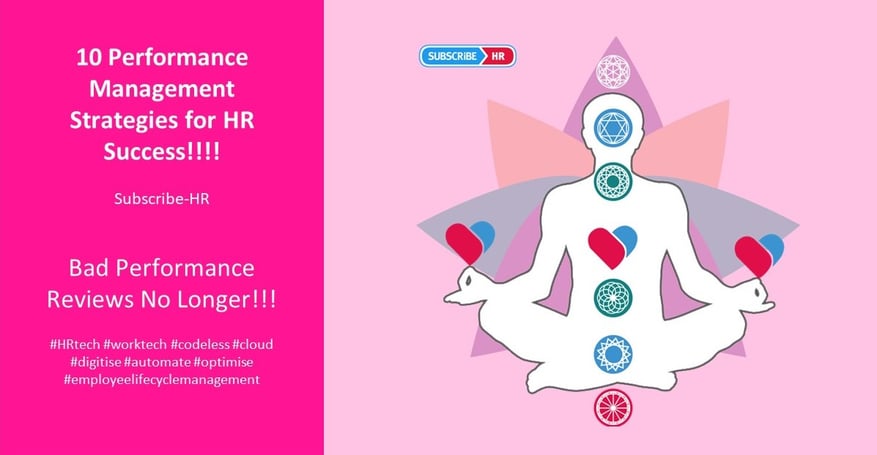Traditional performance management is dead. Gone are the days of 👇
❌ The once-a-year performance review that used to be a hallmark of traditional management, often dubbed as the "annual appraisal."
❌ Managers providing feedback, often in a one-way conversation, with employees as passive recipients.
❌ The use of numerical or categorical ratings (e.g., 1-5 or "exceeds expectations," "meets expectations," etc.) to evaluate performance.
❌ Ranking employees against each other, leading to the infamous "forced ranking" or "rank and yank" approach.
❌ A focus on documentation and paperwork, with extensive forms and reports.
❌ A checkbox approach to performance, emphasising tasks and goals completion.
❌ Employees and managers often dreading the process, viewing it as a necessary evil.
❌ Cumbersome processes, red tape, and a bureaucratic approach to performance management.
❌ Addressing performance issues retrospectively rather than proactively.
Thank goodness for that! Today’s performance management looks more like 👇
✅ An emphasis on ongoing, real-time feedback that promotes open communication between employees and managers, fostering a culture of improvement
✅ A shift towards development and growth, with performance discussions geared towards enhancing skills and capabilities.
✅ A more employee-centric approach, acknowledging that each employee's unique needs and aspirations play a crucial role in their performance.
✅ Frequent check-ins between employees and managers, replacing the annual review model, to address issues promptly and celebrate successes.
✅ Leveraging data and analytics to gain insights into performance trends, enabling informed decision-making and targeted interventions.
✅ Encouraging employees to take ownership of their development and career growth, empowering them to drive their success.
But with so many different strategies to choose from when it comes to modern performance management, how can you make sure you’re following best practices?
Let’s explore the 10 winning strategies we’ve seen as a provider of HR software to help you smash your performance management goals! ✨

10 Winning Performance Management Strategies
Start with organisational goals and build out from there
💡 Our first tip is to begin by aligning your performance management process with your organisation's overarching goals and priorities.
When your performance goals are in sync with your strategic objectives, it enables employees to channel their efforts toward activities that yield meaningful outcomes ✅
And feel free to bring in the tech! Goal-tracking software, office charts, and regular meetings can be your trusty sidekicks in performance management. 👍
With SubscribeHR, for example, you can set specific goals to keep in mind within your performance management practices ⬇️
Set crystal clear expectations
Performance management hinges on understanding the benchmarks for success. Do your employees have a clear understanding of your expectations?
Establishing precise expectations serves as the cornerstone of effective performance management – the strength of your outcomes depends on the clarity of your expectations. ✨
Make sure you set those expectations from the get-go. Utilise job descriptions, goal-setting initiatives, and your company's core values as reference points.
This goes beyond telling employees what your goals are. It involves clearly articulating the why behind your expectations to give employees a deeper understanding of their significance within the larger context. ✅
Track, follow, and check-in
Once you’ve clearly set goals and communicated these objectives in detail to your employees, you’ll be able to start the crucial process of following up.
💡 Our strategy here is to regularly assess goal progress. Try and check in often to identify both successes and the areas that need improvement.
When you track progress efficiently, you can provide the support and coaching necessary to facilitate success 👍
Encourage discussions and feedback

In traditional performance management, feedback comes mainly from managers and supervisors. But nowadays, HR leaders have come to realise that peers, customers, mentors, project leads, and employees themselves can also provide valuable feedback.
It’s really important to give employees constructive feedback so that they can learn and grow. And we’ve come to learn that multiple feedback sources enhance performance management and help employees improve. ✅
💡 Our tip is to use a platform that boosts trust and performance by seamlessly showing employees what’s going well and where they need to improve.
Effective feedback tools can look like:
- Upward feedback
- Downward feedback
- 180-degree feedback
- 360-degree feedback
- Anonymous feedback
- Attributed feedback
👉 There are many ways you can encourage discussion and feedback, and they all do their part in helping employees grow, leading to more consistent results.
Notice the small things too
Recognise employees for all of their positive contributions, regardless of how big or small. Employers who acknowledge efforts are able to significantly boost motivation and morale – which in turn encourages employees to sustain positive behaviours!
💡 Our strategy is to implement a recognition platform to share employee successes across your organisation. Showcase your team’s importance, and make them feel valued and appreciated. 🫶
Use automation to support your efforts

Here at SubscribeHR, we’re firm believers in using automation to support humans in doing what they do best. 👍
There are so many ways automation can help your organisation succeed in performance management. Let’s go through a few of our favourites ⬇️
Performance review scheduling and reminders
Implement automated systems to schedule performance reviews and send reminders to managers and employees.
Automation scenario ➡️ Set up an HR software tool to automatically send notifications for upcoming review deadlines.
Data collection
Use automation to collect performance-related data, such as key performance indicators (KPIs), and aggregate it into a centralised database.
Automation scenario ➡️ Integrate data from various sources (e.g., CRM, project management software) into a performance dashboard.
Goal setting and feedback facilitation
Deploy automated tools that facilitate the continuous exchange of feedback and the setting of performance goals.
Automation scenario ➡️ Utilise a performance management software that allows employees and managers to provide real-time feedback and track progress.
Analytics and reporting for performance management
Automate the generation of performance reports and analytics, providing insights into employee performance trends.
Automation scenario ➡️ Use data visualisation tools to create automated performance dashboards that update in real-time.
Track and monitor goals
Employ automation to track employees' progress toward their performance goals and provide alerts when milestones are achieved or missed.
Automation scenario ➡️ Utilise project management software to set and track individual and team goals.
360-degree feedback surveys
Implement automated 360-degree feedback surveys that collect input from peers, subordinates, and supervisors.
Automation scenario ➡️ Use survey software to distribute and collect anonymous feedback from various stakeholders.
Recognition and rewards programs
Automate recognition and rewards programs to acknowledge exceptional performance.
Automation scenario ➡️ Set up an automated system that sends congratulatory messages or rewards when employees achieve specific milestones.
Employee engagement surveys
Use automation to conduct regular employee engagement surveys to gauge overall satisfaction and identify areas for improvement.
Automation scenario ➡️ Deploy survey software that automatically sends out engagement surveys at predetermined intervals.
Performance Improvement Plans (PIPs)
Automatically trigger the creation of performance improvement plans when employees consistently fall below performance expectations.
Automation scenario ➡️ Set up an HR system to initiate PIPs when specific performance thresholds are not met.
Need help in setting up your performance management automations? Contact us, we’re here to help! 🤝

Leave room for trust and respect
Trust, respect, and inclusion are essential for a positive workplace. Without trust and respect, employees will be prone to becoming demotivated or feeling burnt out in their teams.
That’s why it’s crucial to undertake efforts to enhance trust, respect, and inclusion to boost performance. ✅
The rule of thumb to stick to is enabling every employee, no matter their place in your organisation’s hierarchy, to voice their feedback freely. Two-way communication really is the key here! 📣
Prioritise continuous learning
No performance management strategy is complete without incorporating proper learning and development initiatives.
Easy ways of doing this are utilising methods like online training, webinars, cross-training, and peer coaching. The bottom line is that investing in ongoing training is the key to enhancing employee success. 👍
Streamline your process to remove the headache
Encouraging ongoing feedback also means simplifying the performance management process as best as possible. If it’s easy to provide feedback, everyone is more likely to use the system. 💻
💡 Our strategy is to utilise HR automation to send alerts, reminders and prompts to hugely facilitate the process. Provide clear next steps with ongoing prompts and alerts to ensure that performance management remains a priority for both managers and employees.
Another tool HR leaders can leverage is the "K.I.S.S." principle (Keep It Short and Simple) to prioritise straightforwardness.
👉 The "K.I.S.S." principle emphasises the importance of simplicity and clarity in HR policies, procedures, and interactions. This helps you avoid unnecessary jargon, complexity, or verbosity in your communication with employees, managers, and stakeholders.

Utilise 360 degree reviews
What are 360 degree reviews?
360-degree reviews, also known as 360-degree feedback or multi-rater assessments, are a comprehensive performance evaluation method used to gather feedback on an individual's performance from various sources.
The "360-degree" label reflects the idea that feedback comes from all directions – superiors, subordinates, peers, and sometimes even external stakeholders like clients or customers.
Our best strategies for leveraging 360-degree reviews are ⬇️
- Collect input from multiple sources, including peers, supervisors, subordinates, and even clients or customers, to gain a holistic view of an employee's performance.
- Use 360-degree feedback to identify an employee's strengths and areas needing improvement, helping them set meaningful performance goals.
- Create tailored development plans based on the feedback received, guiding employees on how to enhance their skills and competencies.
- Incorporate 360-degree feedback into formal performance appraisals to provide a well-rounded evaluation of an employee's contributions.
- Use feedback to gain insights into an employee's interpersonal skills, teamwork, communication, and leadership abilities.
- Reduce bias by including input from multiple perspectives, promoting more objective evaluations.
- Align individual goals with organisational objectives based on the feedback received, ensuring that employees contribute to broader business goals.
- Establish regular feedback cycles to monitor an employee's progress and track improvements over time.
- Recognize and reward employees for their strengths and achievements highlighted in the 360-degree feedback process.
- Use 360-degree feedback as a tool for continuous improvement, both for individual employees and for refining the performance management process itself.
- Incorporate 360-degree feedback seamlessly into your broader performance management system, aligning it with other evaluation methods and processes.
- Encourage managers and employees to discuss and act on the feedback received, turning it into actionable insights for growth.

Final Thoughts
Performance management is a powerful tool that organisations really just can’t omit from their overarching HR strategy. 🦾
There are so many tools and techniques you can use to seamlessly enrich your performance management processes – it really is astounding. ✨
Including HR technology in your process is a must in this day and age – automation can really do wonders to support your efforts.
Keeping things human and genuine by prioritising communication and feedback is also crucial!
What are your best performance management strategies? Tell us in the comments below! 👇
FAQ: Frequently Asked Questions
How have traditional performance management practices changed over time?
Traditional performance management practices, like annual reviews and numerical ratings, have evolved into more modern approaches. These new practices focus on continuous feedback, employee development, aligning with organisational goals, utilising technology for automation, and promoting two-way communication.
Why is aligning performance management with organisational goals important?
Aligning performance management with organisational goals ensures that employee efforts contribute to the achievement of broader business objectives. It helps employees understand how their work impacts the company's success, making their efforts more purposeful and directed.
What are some strategies for setting clear expectations for employees?
Setting clear expectations involves using job descriptions, goal-setting initiatives, and company core values as reference points. It also includes articulating the reasons behind expectations to provide employees with a deeper understanding of their significance within the larger context.
How can automation be used to support performance management efforts?
Automation can assist in various aspects of performance management, including scheduling performance reviews, collecting and analysing performance-related data, facilitating feedback, generating reports, tracking goal progress, conducting 360-degree feedback surveys, managing recognition programs, conducting employee engagement surveys, and initiating performance improvement plans.
Why is trust and respect important in performance management?
Trust and respect create a positive workplace culture, leading to motivated and engaged employees. Two-way communication fosters trust, allowing employees to freely voice their feedback and concerns, which is essential for effective performance management.
What role does continuous learning play in performance management?
Continuous learning and development initiatives, such as online training, webinars, cross-training, and peer coaching, are essential for enhancing employee success. These opportunities help employees improve their skills, stay motivated, and contribute more effectively to the organisation.
How can organisations streamline their performance management processes?
Organisations can simplify performance management by using HR automation to send alerts, reminders, and prompts. Clear and concise communication is key, following the "K.I.S.S." principle, and making it easy for employees and managers to provide feedback and track progress.
What are 360-degree reviews, and how can they benefit performance management?
360-degree reviews gather feedback on an individual's performance from multiple sources, including peers, supervisors, subordinates, and sometimes external stakeholders. They benefit performance management by providing a holistic view of an employee's strengths and areas needing improvement, guiding development, and aligning individual goals with organisational objectives.
What are some key takeaways or best practices for effective performance management?
Key takeaways include aligning with organisational goals, setting clear expectations, tracking progress, encouraging feedback, recognizing contributions, using automation, fostering trust and respect, prioritising continuous learning, streamlining processes, and leveraging 360-degree feedback for well-rounded evaluations.

